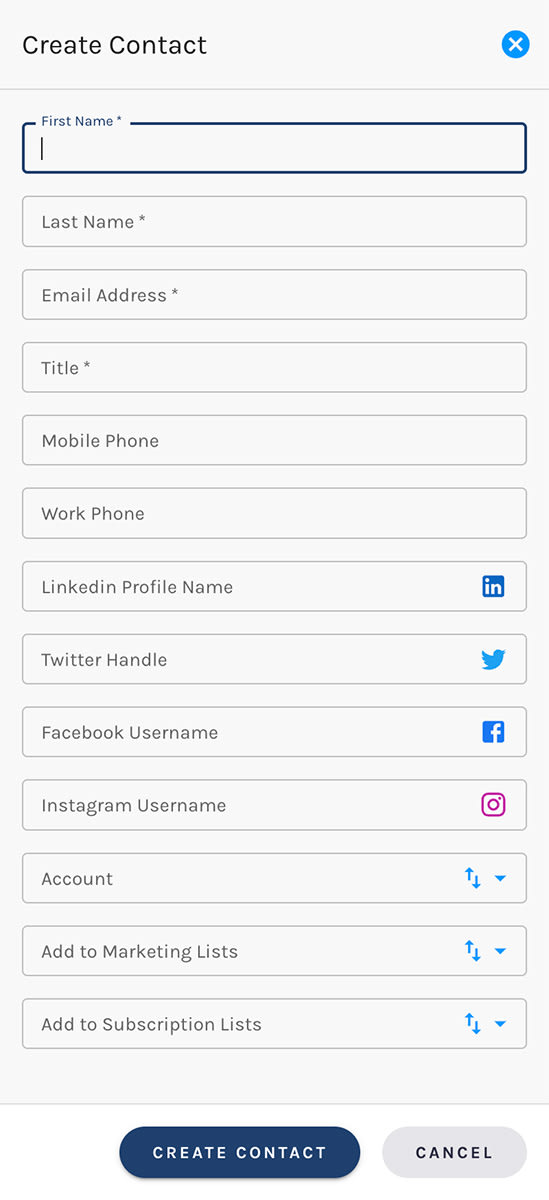Create a Contact
There are a few ways in which a contact can be created in Paminga. Doing so is quick and easy. We will review each method below.
Create a Contact Manually
You can manually add in an individual Contact at any time by navigating the Contacts and Accounts Tab. You will be brought to a blank Contact Detail page where you can enter all known information for your Contact.
Create a Contact Manually

CSV Upload
If you have a current list of Contacts you would like to import into your database, you are able to upload .CSVs easily into the UI. Simply navigate to Contacts & Accounts > Contacts > Import Contacts. Select "Import Contacts" and then Choose your .CSV file.
After selecting your .CSV file, you can add Contacts to an existing Marketing List (or create a new Marketing List on the fly), and map fields so that all information appears in the correct place! (NOTE: We highly recommend having Custom Fields set up before you start importing Contacts.)
Formatting your .CSV
The first row of the file (aka the Header Row) must contain names of the column headings/contact attributes corresponding to the data in that column. All subsequent rows represent a contact you wish to update or add.
Each column, or comma separated field, specifies a contact attribute. Unless you’re composing the file in a text editor, like Notepad, you do not need to put the commas in yourself; this is handled automatically for you in applications like Excel when you choose to save the file in CSV format.
To create in CSV format from Microsoft Excel, choose to Save As, and select CSV (comma delimited) *csv as the File Type.
- MAC USERS: When saving your CSV file in Microsoft Excel, you will want to select the Windows Comma Separated (.csv) format
- Text Qualifiers: This refers to the fourth row in the example above. When the data for a field has a comma in it, that data must be surrounded by text qualifiers (usually quotation marks) so that the comma is not counted as a delimiter. Again, Excel does this automatically for you when you choose to Save As CSV, but you may see them if you open up the file in a text editor.
NOTE: If a value on your CSV file, is set to “-“, and you have mapped your field, and selected “Update that contact with any new information from the .csv file”, any contact who had this value set, will be overwritten to the value of “-“.
Website Visit
Adding the Paminga tracking beacon to your website allows us to create a record for each visitor to your webpage. When a prospect first visits your site they will be assigned a Contact ID and record, and tracked as an anonymous visitor in the Paminga UI.
Should the visitor choose to identify themselves by filling out a form, for example, this Contact file is updated, and they become a known Contact. This entire process happens automatically.
It’s worth noting that Anonymous Contacts (those who visit your site but who have not identified themselves) will not be counted toward your billing total.
Sync From CRM
One of the easiest ways to get Contacts into your instance is through your hourly down sync that occurs with your CRM. Paminga will pull in up-to-date data on Contacts and active Leads.
For more information on syncing with your CRM, check out the articles below:
- DynamicsCRM
- Salesforce CRM
- Sugar CRM
Contact Types
Within your Paminga account there are different contact types.
These include:
- Mailable Contacts
- Non-Mailable Contacts
- Anonymous Contacts
We will review each below.
Mailable Contacts
Mailable contacts are those known Contacts who are eligible to receive email communications.
Paminga considers a contact mailable if they meet the following three criteria:
- The Contact has a valid Email Address
- The Contact is not Bounced
- The Contact is not Unsubscribed
Paminga Automations automatically filter for mailable Contacts, so when adding your conditions to the Participant Tab there is not need to segment out based on email or bounced/unsubscribed status.
Non-mailable Contacts
A Non-mailable Contact refers to a known or unknown Contact who is ineligible to receive email communications via Paminga.
Non-mailable contacts fall into one of three categories:
- Anonymous
- Bounced
- Unsubscribed
Anonymous Contacts
Anonymous Contacts are created when an unknown user visits your web page, while you’re leveraging the Paminga Tracking Beacon. This allows you to learn more about your customer base before they ever convert.
Many Anonymous Contacts eventually convert, such as by submitting a web form. When this happens, we update the Contact file merging known data (such as page visits and duration) to give you a more complete picture of a given contacts behavior.
Non-mailable Contacts, including Anonymous, Bounced, and Unsubscribed do not count toward your monthly billing.


